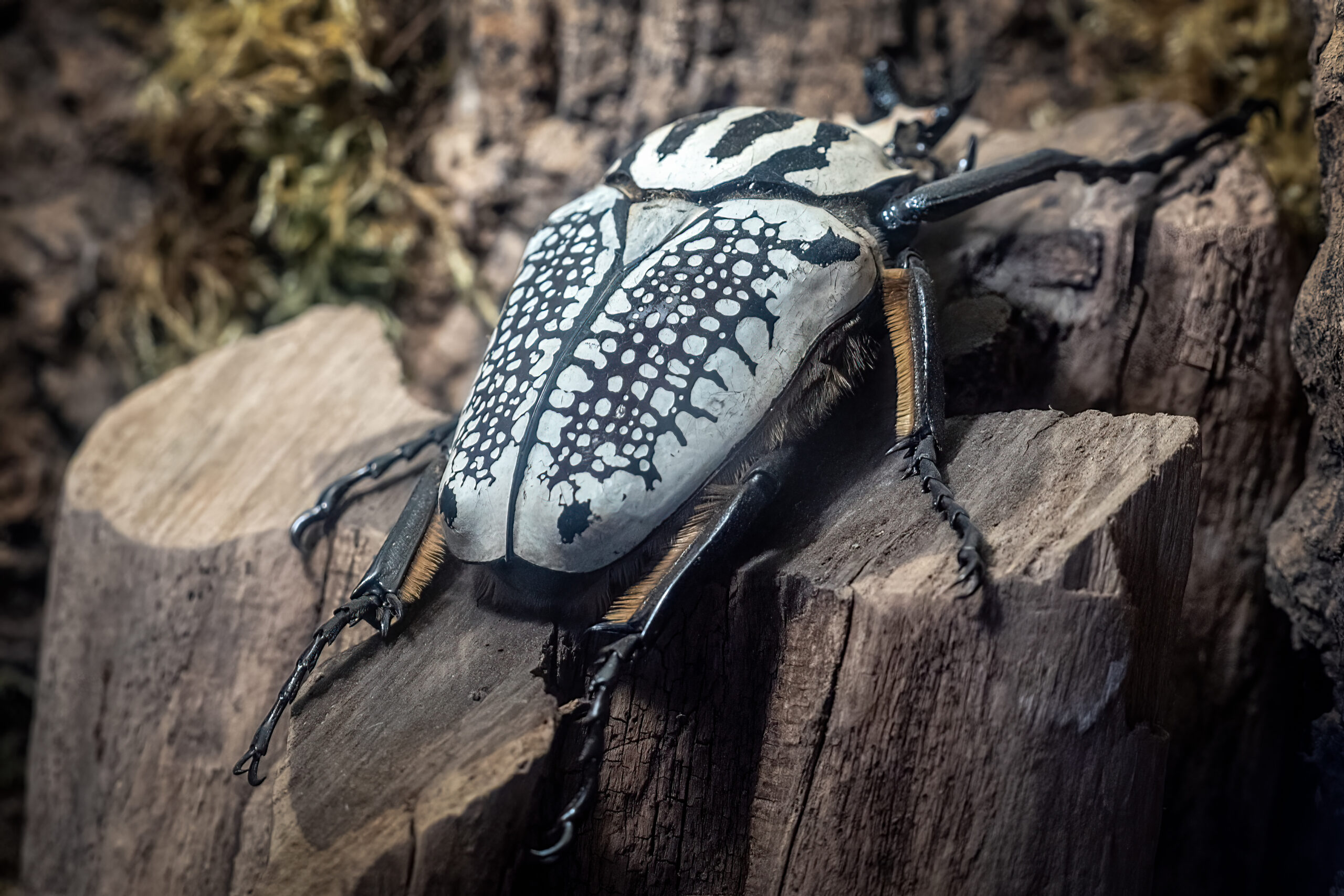Among the countless insect species that inhabit our planet, a select few stand out for their sheer size and weight. Chief among these heavyweights are the mighty Goliath beetles and the enigmatic giant wētā, both of which have earned the distinction of being the world’s heaviest insects.
The Goliath Beetle: A Titan Among Insects
Hailing from the lush rainforests of central and western Africa, the Goliath beetle (Goliathus spp.) is a true giant among its insect counterparts. With a staggering length of up to 6 inches (15 cm) and a weight that can reach a whopping 3.5 ounces (100 grams), these beetles are the undisputed champions of size in the insect world.

Remarkable Physical Attributes
The Goliath beetle’s impressive dimensions are complemented by its equally striking appearance. Adorned with a distinctive pattern of black, white, and brown, and a lustrous metallic sheen on their exoskeleton, these beetles are lookers! Male Goliath beetles can be easily identified by their Y-shaped horns, which they use in fierce battles with rivals for access to feeding sites and mates.
Incredible Strength and Capabilities
Despite their massive size, Goliath beetles are surprisingly agile and capable fliers, using their powerful wings to navigate their forest habitats. Their strength is truly astounding, with the ability to carry up to 850 times their own body weight – the equivalent of a human lifting almost 65 tons (for reference: a humpback whale weighs around 50 tons)! This remarkable feat is made possible by the beetles’ robust muscles and efficient leverage provided by their unique skeletal structure.
Ecological Significance
Goliath beetles play a vital role in the rainforest ecosystem, serving as pollinators and providing a valuable food source for various predators, such as birds and monkeys. Their larvae, which can grow up to 4 inches (10 cm) long, play a crucial role in the decomposition of organic matter, helping to recycle nutrients and maintain the health of the forest.
The Giant Wētā: A Prehistoric Heavyweight
While the Goliath beetle may reign supreme in terms of overall size, another contender for the title of the world’s heaviest insect can be found in the remote forests of New Zealand: the giant wētā (Deinacrida heteracantha).

A Relic from the Dinosaur Era
The giant wētā is a living fossil, with a lineage that can be traced back to the time of the dinosaurs. These remarkable creatures have remained largely unchanged for millions of years, a testament to their evolutionary success and adaptability.
Impressive Proportions
The giant wētā can grow to an impressive length of around 3 inches (7.5 cm), not including their long legs and antennae. However, it is the weight of these insects that truly sets them apart, with the heaviest verified specimen – a pregnant female – tipping the scales at a staggering 2.5 ounces (71 grams).
Unique Adaptations and Behavior
Unlike their more agile Goliath beetle counterparts, the giant wētā have evolved to be less adept at jumping, a trade-off for their immense size. These gentle giants are primarily nocturnal and feed on a variety of plant matter, including fruits, leaves, and even decaying wood.
Conservation Efforts
The giant wētā is a nationally endangered species in New Zealand, and the country has invested significant resources in breeding programs to help reestablish their populations. These efforts are crucial, as the introduction of non-native predators and habitat loss have threatened the survival of this unique insect.
Exploring the Heaviest Insect Contenders
While the Goliath beetle and the giant wētā stand out as the clear heavyweights, the title of the world’s heaviest insect has been the subject of considerable debate over the years. Other contenders include the Actaeon beetle (Megasoma actaeon), the elephant beetle (Megasoma elephas), and the titan beetle (Titanus giganteus).

Larval Weights and Adult Sizes
One point of contention is the distinction between the weights of insect larvae and their adult forms. While some authorities have cited weights of up to 3.5 ounces (100 grams) for certain Goliath beetle species, these figures typically apply to the larval stage, with adult beetles weighing significantly less, in the range of 1.4-1.76 ounces (40-50 grams).
The Heaviest Insect Larva
In 2009, a male Actaeon beetle larva bred in Japan was recorded as the heaviest insect larva, weighing in at an astonishing 8 ounces (228 grams) – roughly the same as a small brown rat. This remarkable specimen highlights the incredible growth potential of some insect species during their larval phase.
The Importance of Insect Conservation
As we delve into the world of the heaviest insects, it becomes increasingly clear that these remarkable creatures face significant threats to their survival. Habitat loss, deforestation, and the introduction of non-native predators have all contributed to the decline of species like the giant wētā and the Goliath beetle.
Protecting Biodiversity
Conserving these insect giants is not just about preserving their unique characteristics; it is also about safeguarding the delicate balance of the ecosystems they inhabit. As keystone species, insects play a crucial role in pollination, nutrient cycling, and providing a food source for other organisms. The loss of these heavyweights could have far-reaching consequences for the overall health and biodiversity of the environments they call home.

